Improving Patient Outcomes: Feedback Systems in Nursing Practice
VerifiedAdded on 2022/10/11
|5
|1260
|8
Report
AI Summary
This report delves into the critical role of feedback within the nursing profession, emphasizing its impact on patient outcomes, staff development, and overall healthcare quality. It begins by defining feedback delivery systems and differentiating between effective and ineffective approaches, highlighting the significance of constructive criticism, specific guidance, and respectful communication. The report explores the importance of feedback in building trust between nurses and patients, improving communication among healthcare staff, and enhancing critical thinking and problem-solving skills, especially in emergency situations. It provides practical examples of how feedback can be applied in clinical settings, such as guiding nursing students and improving time management. The report references several studies to support its claims and concludes with key messages for practice, emphasizing the importance of good communication, time management, and effective task organization. The report also acknowledges the role of supervisors in providing feedback to trainees.
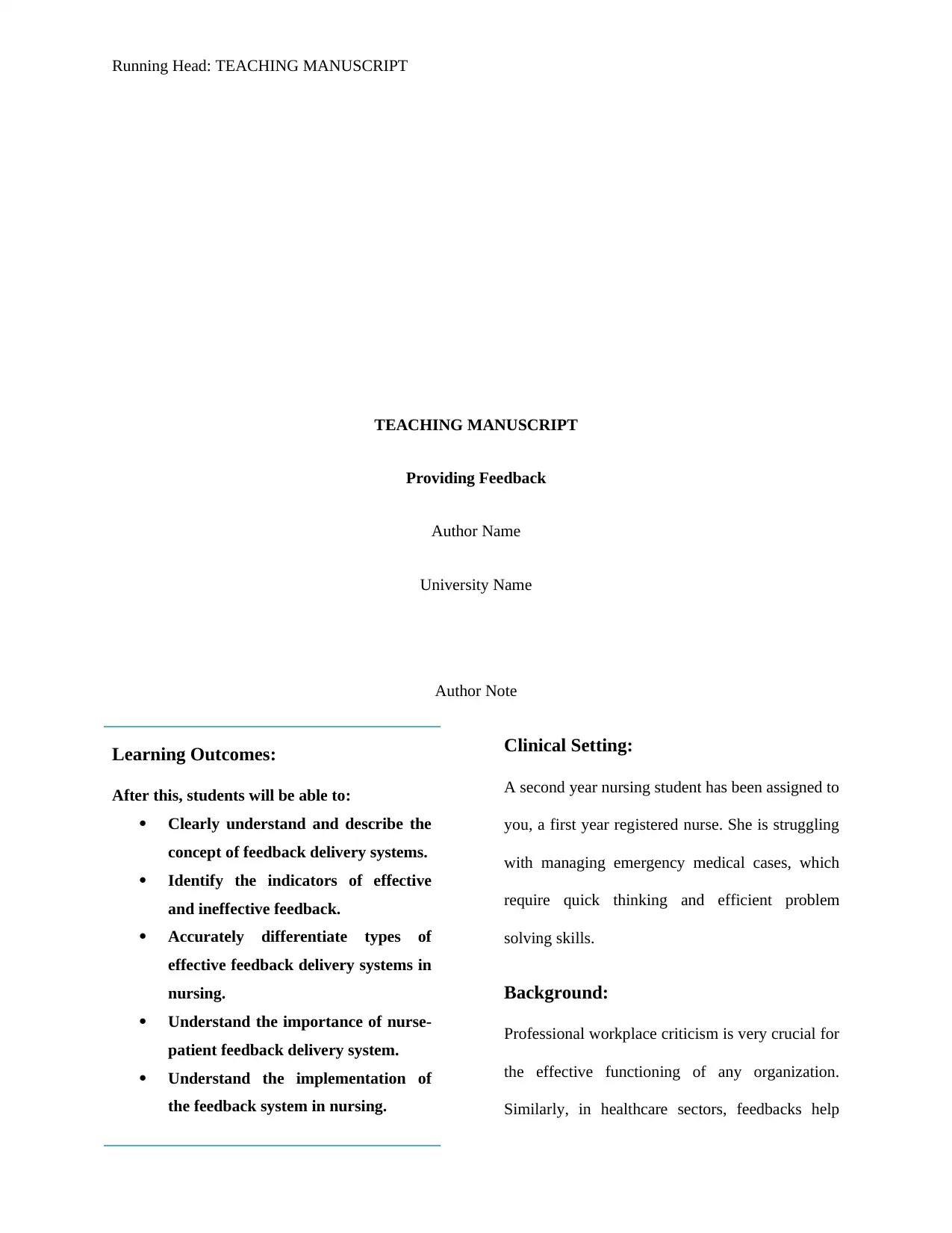
Running Head: TEACHING MANUSCRIPT
TEACHING MANUSCRIPT
Providing Feedback
Author Name
University Name
Author Note
Clinical Setting:
A second year nursing student has been assigned to
you, a first year registered nurse. She is struggling
with managing emergency medical cases, which
require quick thinking and efficient problem
solving skills.
Background:
Professional workplace criticism is very crucial for
the effective functioning of any organization.
Similarly, in healthcare sectors, feedbacks help
Learning Outcomes:
After this, students will be able to:
Clearly understand and describe the
concept of feedback delivery systems.
Identify the indicators of effective
and ineffective feedback.
Accurately differentiate types of
effective feedback delivery systems in
nursing.
Understand the importance of nurse-
patient feedback delivery system.
Understand the implementation of
the feedback system in nursing.
TEACHING MANUSCRIPT
Providing Feedback
Author Name
University Name
Author Note
Clinical Setting:
A second year nursing student has been assigned to
you, a first year registered nurse. She is struggling
with managing emergency medical cases, which
require quick thinking and efficient problem
solving skills.
Background:
Professional workplace criticism is very crucial for
the effective functioning of any organization.
Similarly, in healthcare sectors, feedbacks help
Learning Outcomes:
After this, students will be able to:
Clearly understand and describe the
concept of feedback delivery systems.
Identify the indicators of effective
and ineffective feedback.
Accurately differentiate types of
effective feedback delivery systems in
nursing.
Understand the importance of nurse-
patient feedback delivery system.
Understand the implementation of
the feedback system in nursing.
Paraphrase This Document
Need a fresh take? Get an instant paraphrase of this document with our AI Paraphraser
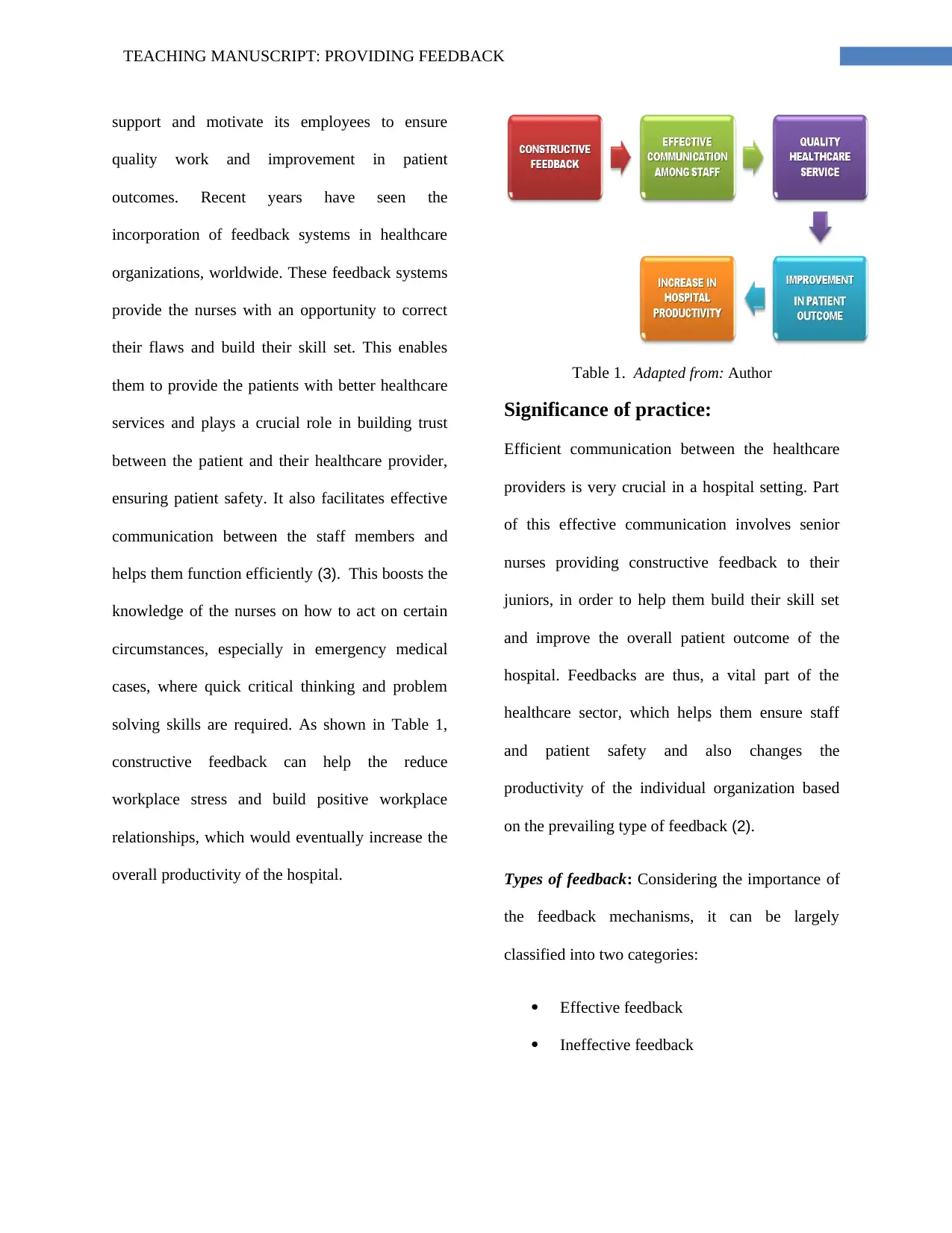
TEACHING MANUSCRIPT: PROVIDING FEEDBACK
support and motivate its employees to ensure
quality work and improvement in patient
outcomes. Recent years have seen the
incorporation of feedback systems in healthcare
organizations, worldwide. These feedback systems
provide the nurses with an opportunity to correct
their flaws and build their skill set. This enables
them to provide the patients with better healthcare
services and plays a crucial role in building trust
between the patient and their healthcare provider,
ensuring patient safety. It also facilitates effective
communication between the staff members and
helps them function efficiently (3). This boosts the
knowledge of the nurses on how to act on certain
circumstances, especially in emergency medical
cases, where quick critical thinking and problem
solving skills are required. As shown in Table 1,
constructive feedback can help the reduce
workplace stress and build positive workplace
relationships, which would eventually increase the
overall productivity of the hospital.
Table 1. Adapted from: Author
Significance of practice:
Efficient communication between the healthcare
providers is very crucial in a hospital setting. Part
of this effective communication involves senior
nurses providing constructive feedback to their
juniors, in order to help them build their skill set
and improve the overall patient outcome of the
hospital. Feedbacks are thus, a vital part of the
healthcare sector, which helps them ensure staff
and patient safety and also changes the
productivity of the individual organization based
on the prevailing type of feedback (2).
Types of feedback: Considering the importance of
the feedback mechanisms, it can be largely
classified into two categories:
Effective feedback
Ineffective feedback
support and motivate its employees to ensure
quality work and improvement in patient
outcomes. Recent years have seen the
incorporation of feedback systems in healthcare
organizations, worldwide. These feedback systems
provide the nurses with an opportunity to correct
their flaws and build their skill set. This enables
them to provide the patients with better healthcare
services and plays a crucial role in building trust
between the patient and their healthcare provider,
ensuring patient safety. It also facilitates effective
communication between the staff members and
helps them function efficiently (3). This boosts the
knowledge of the nurses on how to act on certain
circumstances, especially in emergency medical
cases, where quick critical thinking and problem
solving skills are required. As shown in Table 1,
constructive feedback can help the reduce
workplace stress and build positive workplace
relationships, which would eventually increase the
overall productivity of the hospital.
Table 1. Adapted from: Author
Significance of practice:
Efficient communication between the healthcare
providers is very crucial in a hospital setting. Part
of this effective communication involves senior
nurses providing constructive feedback to their
juniors, in order to help them build their skill set
and improve the overall patient outcome of the
hospital. Feedbacks are thus, a vital part of the
healthcare sector, which helps them ensure staff
and patient safety and also changes the
productivity of the individual organization based
on the prevailing type of feedback (2).
Types of feedback: Considering the importance of
the feedback mechanisms, it can be largely
classified into two categories:
Effective feedback
Ineffective feedback
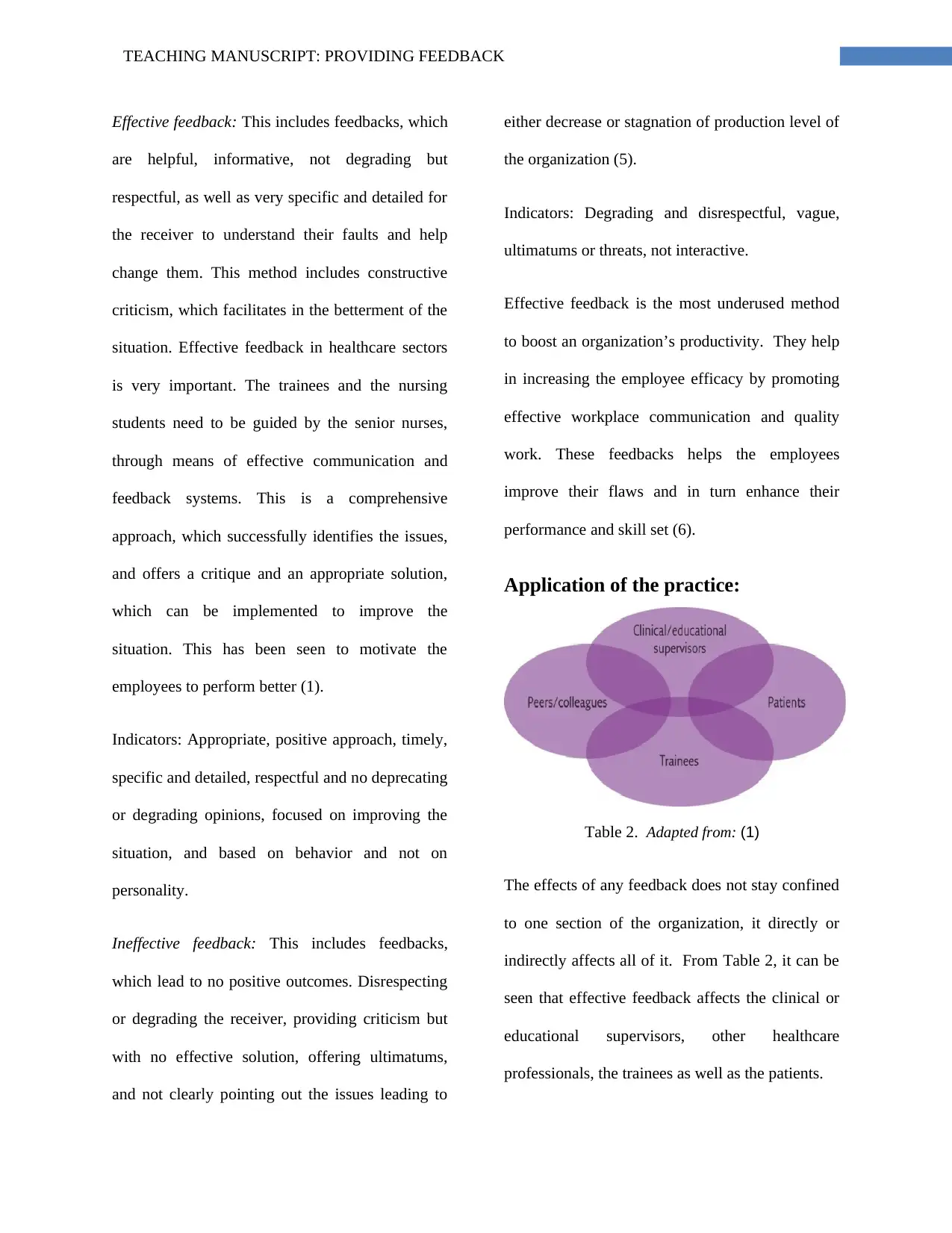
TEACHING MANUSCRIPT: PROVIDING FEEDBACK
Effective feedback: This includes feedbacks, which
are helpful, informative, not degrading but
respectful, as well as very specific and detailed for
the receiver to understand their faults and help
change them. This method includes constructive
criticism, which facilitates in the betterment of the
situation. Effective feedback in healthcare sectors
is very important. The trainees and the nursing
students need to be guided by the senior nurses,
through means of effective communication and
feedback systems. This is a comprehensive
approach, which successfully identifies the issues,
and offers a critique and an appropriate solution,
which can be implemented to improve the
situation. This has been seen to motivate the
employees to perform better (1).
Indicators: Appropriate, positive approach, timely,
specific and detailed, respectful and no deprecating
or degrading opinions, focused on improving the
situation, and based on behavior and not on
personality.
Ineffective feedback: This includes feedbacks,
which lead to no positive outcomes. Disrespecting
or degrading the receiver, providing criticism but
with no effective solution, offering ultimatums,
and not clearly pointing out the issues leading to
either decrease or stagnation of production level of
the organization (5).
Indicators: Degrading and disrespectful, vague,
ultimatums or threats, not interactive.
Effective feedback is the most underused method
to boost an organization’s productivity. They help
in increasing the employee efficacy by promoting
effective workplace communication and quality
work. These feedbacks helps the employees
improve their flaws and in turn enhance their
performance and skill set (6).
Application of the practice:
Table 2. Adapted from: (1)
The effects of any feedback does not stay confined
to one section of the organization, it directly or
indirectly affects all of it. From Table 2, it can be
seen that effective feedback affects the clinical or
educational supervisors, other healthcare
professionals, the trainees as well as the patients.
Effective feedback: This includes feedbacks, which
are helpful, informative, not degrading but
respectful, as well as very specific and detailed for
the receiver to understand their faults and help
change them. This method includes constructive
criticism, which facilitates in the betterment of the
situation. Effective feedback in healthcare sectors
is very important. The trainees and the nursing
students need to be guided by the senior nurses,
through means of effective communication and
feedback systems. This is a comprehensive
approach, which successfully identifies the issues,
and offers a critique and an appropriate solution,
which can be implemented to improve the
situation. This has been seen to motivate the
employees to perform better (1).
Indicators: Appropriate, positive approach, timely,
specific and detailed, respectful and no deprecating
or degrading opinions, focused on improving the
situation, and based on behavior and not on
personality.
Ineffective feedback: This includes feedbacks,
which lead to no positive outcomes. Disrespecting
or degrading the receiver, providing criticism but
with no effective solution, offering ultimatums,
and not clearly pointing out the issues leading to
either decrease or stagnation of production level of
the organization (5).
Indicators: Degrading and disrespectful, vague,
ultimatums or threats, not interactive.
Effective feedback is the most underused method
to boost an organization’s productivity. They help
in increasing the employee efficacy by promoting
effective workplace communication and quality
work. These feedbacks helps the employees
improve their flaws and in turn enhance their
performance and skill set (6).
Application of the practice:
Table 2. Adapted from: (1)
The effects of any feedback does not stay confined
to one section of the organization, it directly or
indirectly affects all of it. From Table 2, it can be
seen that effective feedback affects the clinical or
educational supervisors, other healthcare
professionals, the trainees as well as the patients.
⊘ This is a preview!⊘
Do you want full access?
Subscribe today to unlock all pages.

Trusted by 1+ million students worldwide
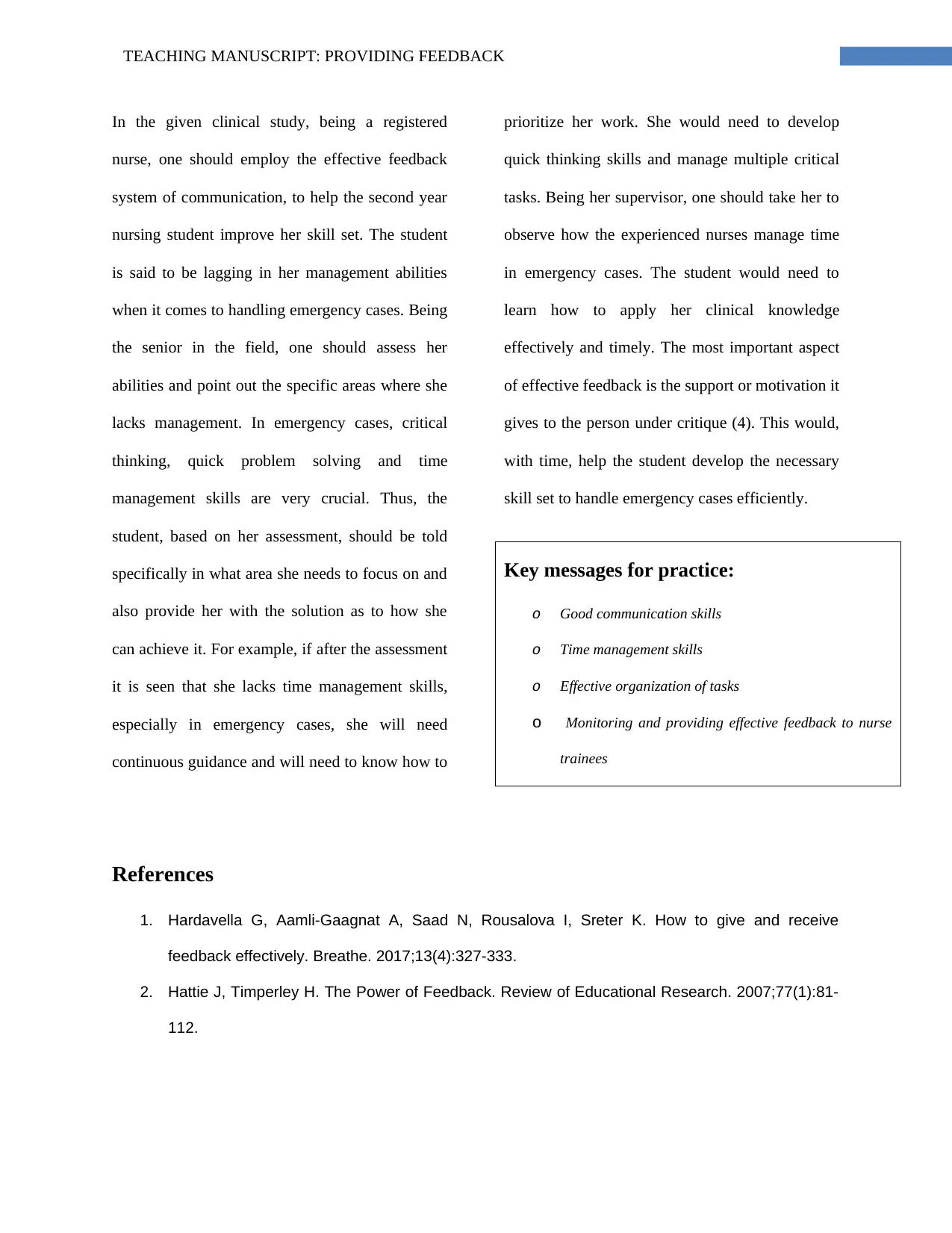
TEACHING MANUSCRIPT: PROVIDING FEEDBACK
In the given clinical study, being a registered
nurse, one should employ the effective feedback
system of communication, to help the second year
nursing student improve her skill set. The student
is said to be lagging in her management abilities
when it comes to handling emergency cases. Being
the senior in the field, one should assess her
abilities and point out the specific areas where she
lacks management. In emergency cases, critical
thinking, quick problem solving and time
management skills are very crucial. Thus, the
student, based on her assessment, should be told
specifically in what area she needs to focus on and
also provide her with the solution as to how she
can achieve it. For example, if after the assessment
it is seen that she lacks time management skills,
especially in emergency cases, she will need
continuous guidance and will need to know how to
prioritize her work. She would need to develop
quick thinking skills and manage multiple critical
tasks. Being her supervisor, one should take her to
observe how the experienced nurses manage time
in emergency cases. The student would need to
learn how to apply her clinical knowledge
effectively and timely. The most important aspect
of effective feedback is the support or motivation it
gives to the person under critique (4). This would,
with time, help the student develop the necessary
skill set to handle emergency cases efficiently.
Key messages for practice:
o Good communication skills
o Time management skills
o Effective organization of tasks
o Monitoring and providing effective feedback to nurse
trainees
References
1. Hardavella G, Aamli-Gaagnat A, Saad N, Rousalova I, Sreter K. How to give and receive
feedback effectively. Breathe. 2017;13(4):327-333.
2. Hattie J, Timperley H. The Power of Feedback. Review of Educational Research. 2007;77(1):81-
112.
In the given clinical study, being a registered
nurse, one should employ the effective feedback
system of communication, to help the second year
nursing student improve her skill set. The student
is said to be lagging in her management abilities
when it comes to handling emergency cases. Being
the senior in the field, one should assess her
abilities and point out the specific areas where she
lacks management. In emergency cases, critical
thinking, quick problem solving and time
management skills are very crucial. Thus, the
student, based on her assessment, should be told
specifically in what area she needs to focus on and
also provide her with the solution as to how she
can achieve it. For example, if after the assessment
it is seen that she lacks time management skills,
especially in emergency cases, she will need
continuous guidance and will need to know how to
prioritize her work. She would need to develop
quick thinking skills and manage multiple critical
tasks. Being her supervisor, one should take her to
observe how the experienced nurses manage time
in emergency cases. The student would need to
learn how to apply her clinical knowledge
effectively and timely. The most important aspect
of effective feedback is the support or motivation it
gives to the person under critique (4). This would,
with time, help the student develop the necessary
skill set to handle emergency cases efficiently.
Key messages for practice:
o Good communication skills
o Time management skills
o Effective organization of tasks
o Monitoring and providing effective feedback to nurse
trainees
References
1. Hardavella G, Aamli-Gaagnat A, Saad N, Rousalova I, Sreter K. How to give and receive
feedback effectively. Breathe. 2017;13(4):327-333.
2. Hattie J, Timperley H. The Power of Feedback. Review of Educational Research. 2007;77(1):81-
112.
Paraphrase This Document
Need a fresh take? Get an instant paraphrase of this document with our AI Paraphraser
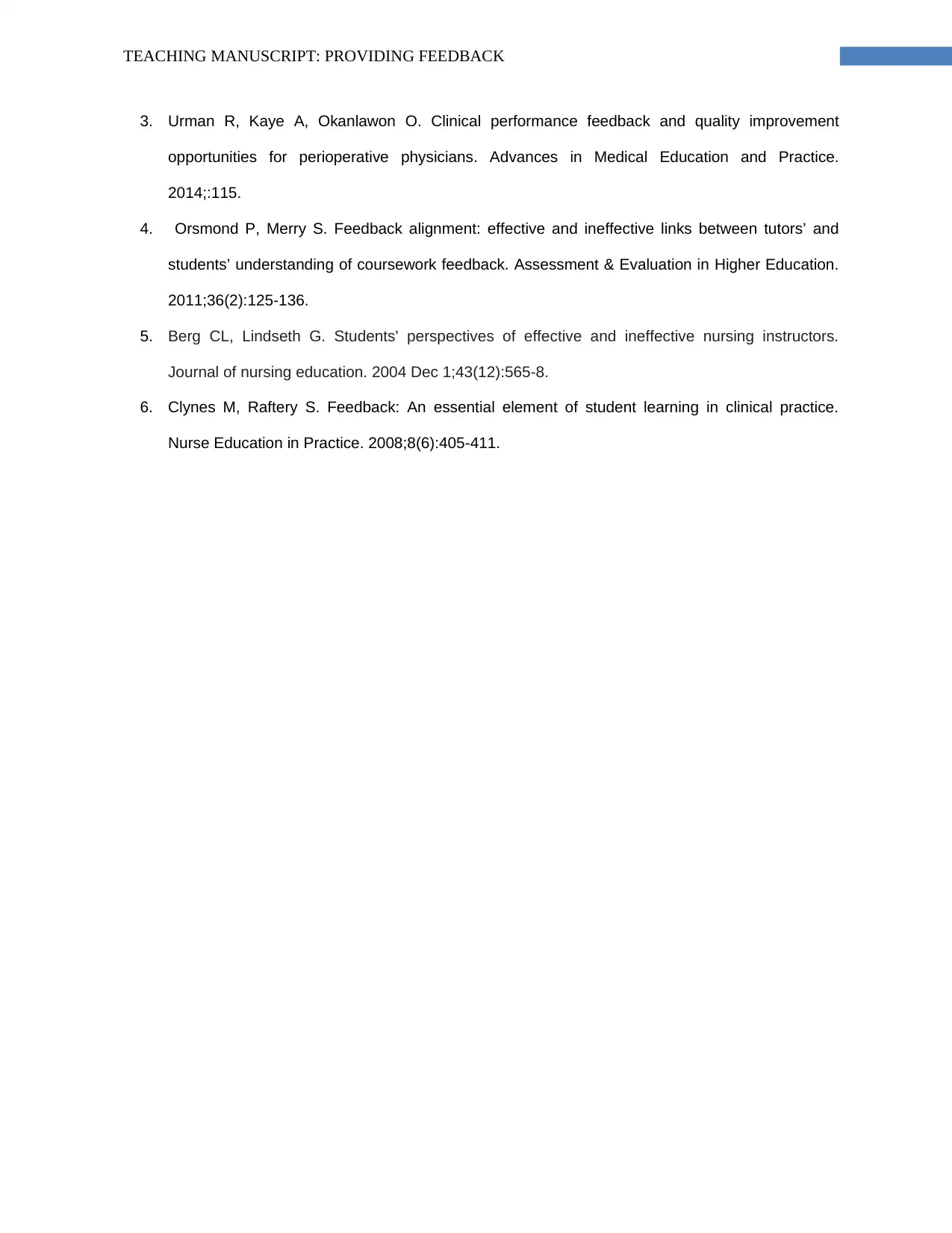
TEACHING MANUSCRIPT: PROVIDING FEEDBACK
3. Urman R, Kaye A, Okanlawon O. Clinical performance feedback and quality improvement
opportunities for perioperative physicians. Advances in Medical Education and Practice.
2014;:115.
4. Orsmond P, Merry S. Feedback alignment: effective and ineffective links between tutors’ and
students’ understanding of coursework feedback. Assessment & Evaluation in Higher Education.
2011;36(2):125-136.
5. Berg CL, Lindseth G. Students' perspectives of effective and ineffective nursing instructors.
Journal of nursing education. 2004 Dec 1;43(12):565-8.
6. Clynes M, Raftery S. Feedback: An essential element of student learning in clinical practice.
Nurse Education in Practice. 2008;8(6):405-411.
3. Urman R, Kaye A, Okanlawon O. Clinical performance feedback and quality improvement
opportunities for perioperative physicians. Advances in Medical Education and Practice.
2014;:115.
4. Orsmond P, Merry S. Feedback alignment: effective and ineffective links between tutors’ and
students’ understanding of coursework feedback. Assessment & Evaluation in Higher Education.
2011;36(2):125-136.
5. Berg CL, Lindseth G. Students' perspectives of effective and ineffective nursing instructors.
Journal of nursing education. 2004 Dec 1;43(12):565-8.
6. Clynes M, Raftery S. Feedback: An essential element of student learning in clinical practice.
Nurse Education in Practice. 2008;8(6):405-411.
1 out of 5
Related Documents
Your All-in-One AI-Powered Toolkit for Academic Success.
+13062052269
info@desklib.com
Available 24*7 on WhatsApp / Email
![[object Object]](/_next/static/media/star-bottom.7253800d.svg)
Unlock your academic potential
Copyright © 2020–2025 A2Z Services. All Rights Reserved. Developed and managed by ZUCOL.





